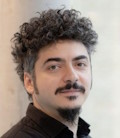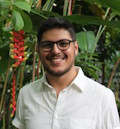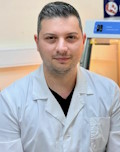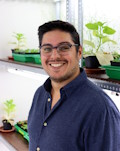Dear colleagues,
In today's newsletter, we will announce our next webinar on the topic “Redox signaling in cancer”. We will also share with you a summary of January’s “Redox mechanisms in plants” webinar, in case some of you didn’t have the chance to join. We will present to you the newest members of the ECR subcommittee. At the end of the newsletter, as always, you can also find a collection of upcoming events with important deadlines and some suggestions of interesting redox reads recently published.
Webinar series “Emerging leaders in redox biology”
Our next webinar will be on 6th February 2024 at 15:00 CET on the topic “Redox signaling in cancer” featuring Salvatore Rizza and Hamed Alborzinia.

Regulation of cell adhesion and anoikis by S-nitrosylation
Salvatore Rizza, PhD
Redox Biology Group, Danish Cancer Institute, Copenhagen, Denmark
Salvatore Rizza is a senior researcher in the lab of Giuseppe Filomeni at the Danish Cancer Institute. His research has centered on redox stress and specifically on the study of GSNOR, a pivotal enzyme regulating the levels of proteins covalently modified by the cellular messenger nitric oxide (NO). In 2016, Salvatore uncovered a crucial link between the absence of GSNOR and mitochondrial respiration, pinpointing SDH as a vulnerability in a subset of tumors. Building on this, he shifted focus to GSNOR dynamics during cell senescence and aging, elucidating the age-dependent GSNOR decline orchestrated by DNA methylation and demethylation reactions. This decline was intricately tied to mitochondrial aberrations, shedding light on the aging process. Further expanding this exploration, he delved into the interplay of NO-signaling and mitochondria homeostasis in immune cells and discovered that under oxidative stress, GSNOR induction led to decreased S-nitrosylation levels, boosting mitophagy and supporting the viability of immune cells facing excessive oxidative and nitrosative stress during activation. In 2023, Salvatore and his colleagues unveiled the prevalence of GSNOR deficiency in most solid tumors, triggering FAK1 hyperactivation and promoting anchorage-independent cell growth. This insight has significant therapeutic implications, as FAK1 inhibitors emerge as potential agents to exploit this vulnerability, effectively positioning GSNOR as a novel therapeutic efficacy marker in cancer research.
 MYCN Mediates Ferroptosis Sensitivity in MYCN-amplified Cancers
MYCN Mediates Ferroptosis Sensitivity in MYCN-amplified Cancers
Hamed Alborzinia, PhD
Heidelberg Institute for Stem Cell Technology and Experimental Medicine (HI-STEM GmbH), Heidelberg, Germany
Division of Stem Cells and Cancer, German Cancer Research Center (DKFZ), Heidelberg, Germany
Hamed Alborzinia graduated in veterinary medicine from Shiraz University (Iran) before enrolling in the Molecular Biology Ph.D. program at Heidelberg University. During his doctoral studies in Heidelberg, he utilized bioanalytical techniques to investigate cancer cell metabolism. In 2018, he joined the Heidelberg Institute for Stem Cell Technology and Experimental Medicine (HI-STEM) and the Division of Stem Cells and Cancer at the German Cancer Research Center (DKFZ) within the lab of Prof. Andreas Trumpp in Heidelberg, Germany. As a Postdoctoral researcher, his primary focus has been on unraveling the metabolic properties of cancer cells, particularly in relation to emerging forms of cell death, such as ferroptosis. Recently appointed as a group leader at HI-STEM/DKFZ, Hamed's main objective is to explore cell death mechanisms in cancer cells, with a specific emphasis on drug resistance. His research group is actively involved in uncovering the novel metabolic cell death pathway of ferroptosis, with the ultimate aim of identifying therapeutic strategies for challenging cancers, including those characterized by MYC deregulation and drug tolerance.
January’s webinar
On January’s webinar we enjoyed two inspiring talks on the topic “Redox mechanisms in plants”:

Exploring plant redox landscapes by developing novel NADP redox biosensors
Jan-Ole Niemeier, MSc
Institute of Plant Biology and Biotechnology (IBBP), Westfälische
Wilhelms-Universität Münster, Germany
Jan-Ole Niemeyer presented their work on the design and characterization of a new genetically encoded biosensor to measure the real-time variations of the NADPH/NADP+ pool in plants exposed to different conditions. His results using this sensor, further revealed the glutathione buffer to be essential in the detoxification of exogenously added hydrogen peroxide (H2O2) in plant cells.

Let it shine: Monitoring plant live dynamic with fluorescent biosensors
José Manuel Ugalde, PhD
Institute of Crop Science and Resource Conservation (INRES) - Chemical Signalling, University of Bonn, Germany
Dr. Ugalde introduced the dual role of H2O2 as signaling or toxic molecule in cells depending on its concentration, and how critical it is to follow H2O2 levels with spatial and temporal resolution to understand its role as messenger. His results using genetically encoded sensors to follow H2O2 levels and the redox state of the glutathione buffer, revealed the relevance of different cellular detoxification pathways to modulate intracellular ROS levels under stress in real time.
Welcome to the new members of the ECR subcommittee!
We are very pleased to present to all of you the four new members of the ECR subcommittee! They will support us in the webinar, social media and conference team.

Ufuk Ersoy
I completed my undergraduate studies in physiotherapy at Dokuz Eylul University in Izmir, Turkey. Following a brief stint as a physiotherapist, I realized that the hospital environment wasn’t aligned with my passion for exploration and discovery. Driven by this desire, I decided to pursue my dreams further and enrolled in postgraduate studies at the University of Liverpool. I successfully earned my MRes degree, specializing in CIMA musculoskeletal ageing, just as the COVID pandemic emerged.
Despite spending only a month in the labs, the experience was impactful, fuelling my decision to apply for a PhD position within the same department. Currently, I am in the final year of my PhD program at the University of Liverpool. My research focuses on unravelling the impact of maternal undernutrition on skeletal muscle aging. The goal is to comprehend whether suboptimal nutrition triggers an accelerated aging phenotype in skeletal muscle, with a specific emphasis on understanding the associated impairments in redox signalling and mitochondrial homeostasis. I enjoy travelling, football, basketball, reading, and the gym :)
- What annoys you in the lab? People who whistle :@
- What do you like to do the most in the lab? Not western blot
- What is your favourite thing to do for celebrating a successful experiment? A pint of beer (or any drink) :)
- Which was your first spot in your lab coat? Cannot remember but probably my tears after a failed experiment :D

Verónica Miguel
I’m a postdoc researcher in the immunobiology laboratory at the Spanish National Centre for Cardiovascular Research (Dr. David Sancho´s lab).
My research focuses on the immunometabolic control of macrophage functions. I studied Biotechnology at the University of León (Spain). I was fascinated about cellular metabolism and its alterations during disease development. So, I pursued a MSc in Molecular Biomedicine at the Autonomous University of Madrid and completed a PhD at the Center for Molecular Biology “Severo Ochoa” in Spain (Dr. Santiago Lamas´ lab). I was dedicated to investigate the role of fatty acid oxidation in chronic kidney disease. I identified new miRNAs involved in renal fibrosis related to the regulation of redox and metabolic pathways. My research training includes four stays in the USA, in laboratories of Alabama, Yale, Pennsylvania and Harvard Universities. In 2021, she joined Dr. Kramann’s laboratory at the University Hospital RWTH Aachen as a postdoctoral FEBS fellow, where I developed novel methodologies enabling the study of metabolism in renal organoids.
- What annoys you in the lab? Empty reagent tubes.
- What do you like to do the most in the lab? To discuss new findings.
- What is your favourite thing to do for celebrating a successful experiment? To take a break and eat some chocolate!
- Which was your first spot in your lab coat? Trypan blue while cell counting.

Konstantinos Papanikolaou
I’m a Postdoc in the Exercise Biochemistry, Physiology and Nutrition lab at the Department of Physical Education and Sport Science of the University of Thessaly, Greece. My research interests are focused on exercise redox biology and skeletal muscle metabolism and regeneration.
I studied Exercise Science at the Democritus University of Thrace, Greece. Since my first years, I was a member of the physical performance lab where I conducted an experimental undergraduate thesis on human physiology and performance. Then, I completed a Master’s degree in Exercise and Health for clinical populations at the University of Thessaly, Greece, where I was introduced to the field of redox biology. At this time, I explored several topics including the impact of exercise and nutritional interventions on redox signaling, muscle physiology and inflammation. For my PhD thesis, I investigated the redox-dependent regulation of skeletal muscle stem cells following exercise-induced injury in humans, a topic that I am still working on. During that time, I had the privilege to complete a research training in the lab of Prof. Dr. Tilman Grune in the Department of Molecular Toxicology at DIfE, Germany, where I was able to deepen my knowledge by applying novel techniques and methodologies to study redox processes.
- What annoys you in the lab? Dirty and messy benches.
- What do you like to do the most in the lab? Fluorescence microscopy.
- What is your favourite thing to do for celebrating a successful experiment? Drinking a cold beer.
- Which was your first spot in your lab coat? A marker pen stain, I guess.

José Manuel Ugalde
I’m a Jr. Group leader at the University of Bonn, Germany. My research focuses on the characterization of gene superfamilies linked to plant cell detoxification, and the modulation of cellular redox homeostasis.
My motivation to understand how our environment works led me to study biochemistry as a way to see the mechanics of life processes in detail. Through my studies, I had the chance to work in plant biology and became immediately fascinated with plants’ resilience and adaptability. After my Master’s thesis characterizing essential genes in pollen development, I did a PhD in Molecular genetics at the Pontifical Catholic University of Chile, focusing on the study of the antioxidant role of the phytohormone salicylic acid (SA) at the Lab of Dr. Loreto Holuigue. Since I wanted to measure redox dynamics in plant cells, I went to the lab of Dr. Andreas Meyer at the University of Bonn, Germany, during two internships. There, I became fond, and a huge fan, of genetically encoded fluorescent biosensors as a tool for real-time monitoring of redox biology. At the moment, I am starting my independent research group in Bonn, focused on the redox dynamics of different cellular sub-compartments and the characterization of large redundant gene families related to cell redox modulation and detoxification processes. I am a science communication enthusiast, for which I have worked for the past two years as an associated features editor at Plant Physiology, highlighting top research as short and approachable articles with funny titles.
- What annoys you in the lab? Finding an empty box of competent cells, Or an empty bottle of a common reagent.
- What do you like to do the most in the lab? My Friday afternoons. Saved for me to do all the new, fun, and sometimes weird experiments ^.^’
- What is your favourite thing to do for celebrating a successful experiment? Print a copy, tape it to my office door and have a beer.
- Which was your first spot in your lab coat? Don’t know if it was the first, but I remember many with crystal violet and safranin from my microbiology classes.
More information about the ECR Subcommittee can be found on the SFRR-E website (ECR Committee), while regular updates can be found on Twitter (@SFRR_Europe) and Instagram (@sfrr_ecr). For any question or suggestion you might have, you can contact us via email:
Hope to see you online for our next Webinar Series appointment,
The ECR subcommittee
Upcoming events:
SFRR-E Annual Meeting
- 5-7 June 2024
- Location: Istanbul, Turkey
- From Molecules to Tissues: Redox Biology in Action
- Further information: https://www.redoxistanbul2024.com/
Thiol-Based Redox Regulation and Signaling Gordon Conference
- GRS: 13-14 July 2024
- Deadline: applications must be submitted by 15 June 2024, any applicants who wish to be considered for an oral presentation should submit their application by 7 April 2024.
- GRC: 14-19 July 2024
- Deadline: applications must be submitted by 16 June 2024
- Location: Castelldefels, Barcelona, Spain
- Further information: https://www.grc.org/thiol-based-redox-regulation-and-signaling-conference/2024/
SFRR-E Summer School / FEBS Advanced Lecture Course
- Redox biochemistry: cellular responses and disease relevance
- 30 September - 6 October 2024
- Location: Spetses, Greece
- Deadlines:
- YTF and Grant Applications: 15 April 2024
- Registration & Abstract Submission Closing: 15 April 2024
- Further information: https://redoxbiochemistry2024.febsevents.org
Interesting Redox Reads:
Timson, R.C., Khan, A., Uygur, Saad, M., et al. Development of a mouse model expressing a bifunctional glutathione synthesizing enzyme to study glutathione limitation in vivo. JBC (2024). https://doi.org/10.1016/j.jbc.2024.105645
Megarioti, A., Esch, B. M., Athanasopoulos, A., et al. Ferroptosis-protective membrane domains in quiescence. Cell Rep (2023). https://doi.org/10.1016/j.celrep.2023.113561
Jakubek, P., Suliborska, K., Kuczyńska, M., et al. The comparison of antioxidant properties and nutrigenomic redox-related activities of vitamin C, C-vitamers, and other common ascorbic acid derivatives. Free Radic Biol Med (2023). https://doi.org/10.1016/j.freeradbiomed.2023.10.400
Shi, X., DeCiucis, M., Grabinska, K. A., et al. Dual regulation of SLC25A39 by AFG3L2 and iron controls mitochondrial glutathione homeostasis. Mol Cell (2023). https://doi.org/10.1016/j.molcel.2023.12.008
Hendricks, J. M., Doubravsky, C. E., Wehri, E., et al. Identification of structurally diverse FSP1 inhibitors that sensitize cancer cells to ferroptosis. Cell Chem Biol (2023). https://doi.org/10.1016/j.chembiol.2023.04.007
Geeson, M. B., Hsiao, J. C., Tsamouri, L. P., et al. The interaction between NLRP1 and oxidized TRX1 involves a transient disulfide bond. Cell Chem Biol (2024). https://doi.org/10.1016/j.chembiol.2023.12.012
García-Giménez, J. L., Irene Cánovas-Cervera, I. & Pallardó, F. V. Oxidative stress and metabolism meet epigenetic modulation in physical exercise. Free Radic Biol Med (2024). https://doi.org/10.1016/j.freeradbiomed.2024.01.008
Zhuravlev, A., Ezeriņa, D., Ivanova, J., et al. HyPer as a tool to determine the reductive activity in cellular compartments. Redox Biology (2024) https://doi.org/10.1016/j.redox.2024.103058
Call for papers:
Journal: Free Radical Biology and Medicine
- Special Issue: Vitamin E Discussion Forum
- Deadline: submit your manuscript before 31 January 2024
- More information:
- https://www.sciencedirect.com/journal/free-radical-biology-and-medicine/about/call-for-papers
Journal: Redox Biochemistry and Chemistry
- Special Issue: NO Nobel Prize 25th Anniversary
- Deadline: submit your manuscript before 15 March 2024
- More information:
- https://www.sciencedirect.com/journal/redox-biochemistry-and-chemistry/about/call-for-papers
